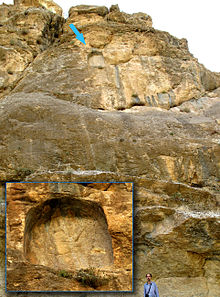User:Ichthyovenator/Urartu–Assyria War
(from Sargon II)
[edit]
Urartu remained Sargon's main strategic rival in the north.[1] In 715, Urartu was severely weakened by an unsuccessful expedition against the Cimmerians, a nomadic people in the central Caucasus. The army was defeated, commander-in-chief Kakkadana was captured and Rusa fled the battlefield. The Cimmerians penetrated deep into Urartu, raiding Urartian lands as far as immediately south-west of Lake Urmia. Rusa also had to deal with Ullusunu of Mannea, now aligned with Assyria.[2] Rusa seized some of Ullusunu's fortresses and replaced him with Daiukku as the new king. Daiukku's loyalty was ensured through Rusa taking his son hostage. Months later, Sargon invaded Mannea, recaptured Ullusunu's fortresses and restored him to the throne. Rusa attempted to drive Sargon back, but his army was defeated in the foothills of Sahand. Sargon also received the tribute of Ianzu, king of Nairi, another former Urartian vassal.[3] Preparing for a campaign against Rusa, Sargon defeated some minor rebels in Media. In Anatolia, Urik of Quwê, changed his allegiance from Sargon to Midas of Phrygia and began sending envoys to Rusa. To prevent the formation of a northern alliance, Sargon attacked Quwê, defeating Urik and recapturing some cities that had fallen to Midas. Quwê was abolished as a vassal kingdom and annexed.[4]
Rusa knew that the Assyrians were likely to exploit his recent string of defeats to invade Urartu and kept most of his army by Lake Urmia, close to the Assyrian border, which was already fortified against Assyrian invasion.[2] The shortest path from Assyria to the Urartian heartland went through the Kel-i-šin pass in the Taurus Mountains. One of the most important places in all of Urartu, the holy city Musasir, was located just west of this pass, which meant that it required extensive protection by fortifications. Awaiting Sargon's attack, Rusa ordered the construction of a new fortress called the Gerdesorah. Measuring about 95 x 81 meters (311.7 x 265.7 ft), the fortress was strategically positioned on a hill about 55 meters (180.4 ft) high and had 2.5 (8.2 ft) meter thick walls and defensive towers.[5] The Gerdesorah was still under construction when the Assyrians invaded.[6]

Sargon left the Assyrian capital of Nimrud in July 714. Rejecting the shortest route through the Kel-i-šin pass, Sargon marched his army through the valleys of the Great and Little Zab for three days before halting near Mount Kullar (the location of which remains unidentified). There Sargon chose a longer route through Kermanshah, probably since he knew the Urartians anticipated him attacking through the pass.[7] The longer route delayed the Assyrians with mountains and greater distance.[7] The campaign had to be completed before October, when the mountain passes would become blocked by snow. This meant that conquest, if that had been the intention, would not be possible.[7]
Once Sargon reached Gilzanu, near Lake Urmia, he made camp and considered his next move. The Urartian forces, surprised by the direction of attack, had to abandon their original plan, regroup and build new fortifications west and south of Lake Urmia.[8] Though Sargon's forces had been granted supplies and water by his vassals in Media, his troops, having marched through difficult and unfamiliar terrain, were exhausted and nearly mutinous. When Rusa finally arrived, the Assyrian army refused to fight. Sargon assembled his bodyguards and led them in a near-suicidal charge against the nearest wing of the Urartian forces, throwing himself into the battle. Sargon's charge inspired his army to follow him. After some fighting, the Urartians were defeated and were chased westwards by the Assyrians far past Lake Urmia. Rusa abandoned his forces and fled into the mountains.[9]
Having defeated Rusa and perhaps fearing that his army might turn on him if he pushed further, Sargon decided to return to Assyria.[10] On their way home, the Assyrians destroyed the Gerdesorah and captured and plundered Musasir[8] after the local governor, king Urzana, refused to welcome Sargon. Urzana's palace was looted, as was the sanctuary dedicated to the god Haldi. An enormous quantity of spoils were carried back to Assyria and Musasair was annexed. Urzana was forgiven and allowed to continue to govern Musasair as an Assyrian vassal. Though Urartu remained powerful and Rusa retook Musasir, probably in 713, the 714 campaign put an end to direct confrontations between Urartu and Assyria for the rest of Sargon's reign.[11] Sargon considered the campaign one of the major events of his reign. It was described in exceptional detail in his inscriptions and several of the reliefs in his palace were decorated with representations of the sack of Musasir.[12]
References
[edit]- ^ Frahm 2017, p. 181.
- ^ a b Jakubiak 2004, p. 192.
- ^ Elayi 2017, pp. 227–228, 230.
- ^ Elayi 2017, pp. 228–229.
- ^ Jakubiak 2004, p. 191.
- ^ Jakubiak 2004, p. 194.
- ^ a b c Jakubiak 2004, p. 197.
- ^ a b Jakubiak 2004, p. 198.
- ^ Bauer 2007, p. 377.
- ^ Bauer 2007, p. 378.
- ^ Elayi 2017, p. 231.
- ^ Elayi 2017, p. 229.
Bibliography
[edit]- Bauer, Susan Wise (2007). The History of the Ancient World: From the Earliest Accounts to the Fall of Rome. New York: W. W. Norton & Company. ISBN 978-0-393-05974-8.
- Elayi, Josette (2017). Sargon II, King of Assyria. Atlanta: Society of Biblical Literature Press. ISBN 978-1-62837-177-2.
- Frahm, Eckart (2017). "The Neo-Assyrian Period (ca. 1000–609 BCE)". In E. Frahm (ed.). A Companion to Assyria. Hoboken: John Wiley & Sons. ISBN 978-1-444-33593-4.
- Jakubiak, Krzysztof (2004). "Some remarks on Sargon II's eighth campaign of 714 BC". Iranica Antiqua. 39: 191–202. doi:10.2143/IA.39.0.503895.
